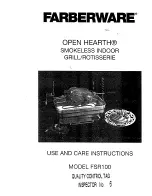
5
HD25Bi 22/09/15
4.0
Installation Information
Chimney
The chimney height and the position of the chimney terminal should conform to Building Regulations.
Minimum chimney height is 4.5m. Check that the chimney is in good condition, dry, free from cracks and
obstructions. The diameter of the flue should not be less than 150mm and not more than 200mm. If any of
these requirements are not met, the chimney should be lined by a suitable method. The chimney must be
swept before connection to the stove.
Where the chimney is believed to have previously served an open fire installation, it is possible that the
higher flue gas temperature from the stove may loosen deposits that were previously firmly adhered, with
the consequent risk of flue blockage. It is therefore recommended that the chimney be swept a second time
within a month of regular use after installation.
If you have any doubts about the suitability of your chimney, consult your local dealer/stockist or chimney
specialist. If there is no existing chimney then either a solid fuel compatible prefabricated block chimney or
a twin-walled insulated stainless steel flue to BS 4543 can be used. These chimneys must be fitted in
accordance with the manufacturer’s instructions and Building Regulations.
Ventilation
No purpose provided ventilation is required for stoves rated under 5KW. For each KW above 5KW, 550 sq
mm of fixed ventilation is required – i.e. a stove rated at 8KW would require 3 x 550 sq mm = 1650 sq mm
of fixed ventilation. If more than one appliance is installed in the same room, the ventilation requirements
for each appliance must be added together.
Flue Draught
A flue draught of minimum 1.6mm to a maximum 2.5mm water gauge (16 to 25 Pascals) is required for
satisfactory appliance performance. The flue draught should be checked under fire at high output and, if it
exceeds the recommended maximum, a draught stabiliser must be fitted so that the rate of burning can be
controlled to prevent over-firing.
Connection to the Chimney
This appliance is
not
suitable for use in a shared flue. This appliance requires a direct flue connection to the
spigot. It is
essential
that all connections between the stove and chimney-flue are sealed and made airtight
with sealing rope, clamping rings and/or fire cement or heat resisting cement where required.
Both the chimney and flue pipe must be accessible for cleaning and if ANY parts of the chimney cannot be
reached through the stove (with baffle removed), a soot door must be fitted in a suitable position to enable
this to be done.
In adverse weather conditions, downdrafts may occur causing smoke or fumes to spill into the room. If this
occurs the appliance should be shut down as much as possible by closing the air controls and the room
should be ventilated to clear the fumes. If the problem persists seek the advice of a chimney sweep.
Material Clearances
Safety Distances from Combustible Surfaces:
Model
Side
Shelf
HD25Bi
150mm
550mm
In addition it is strongly recommended that any furniture or other combustible materials are kept at least
1000mm clear from the front of the stove.







































